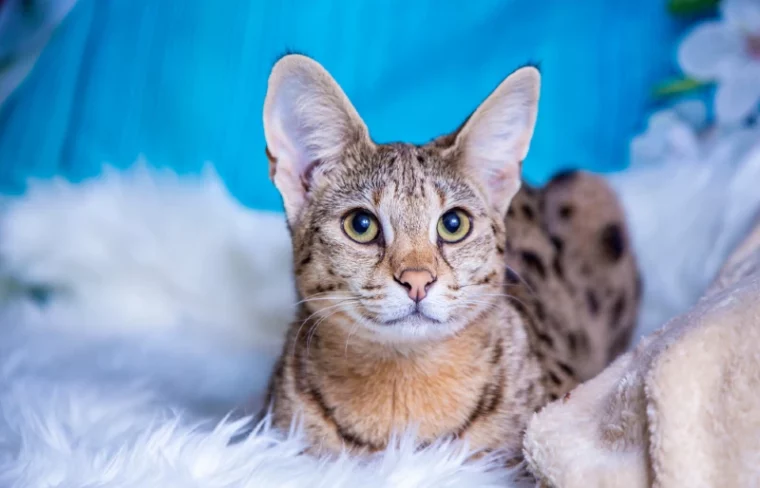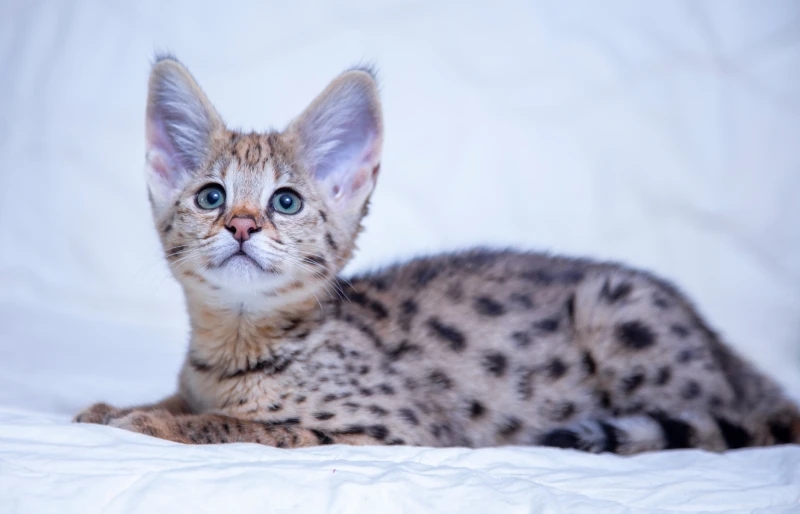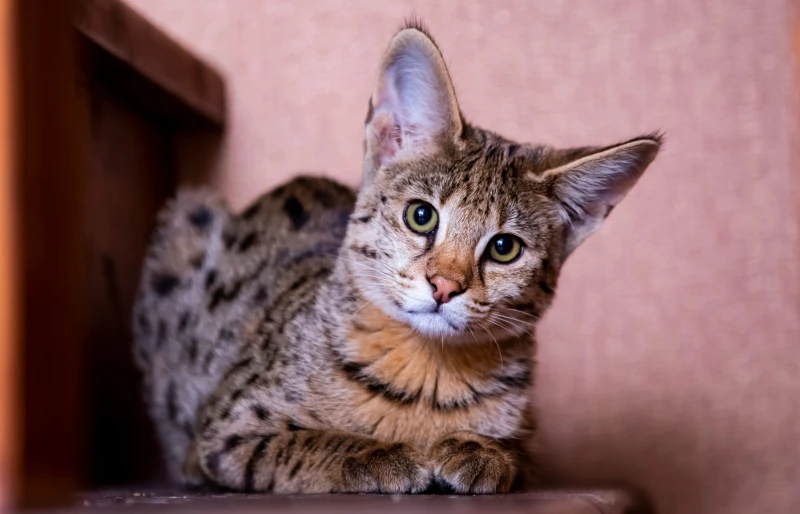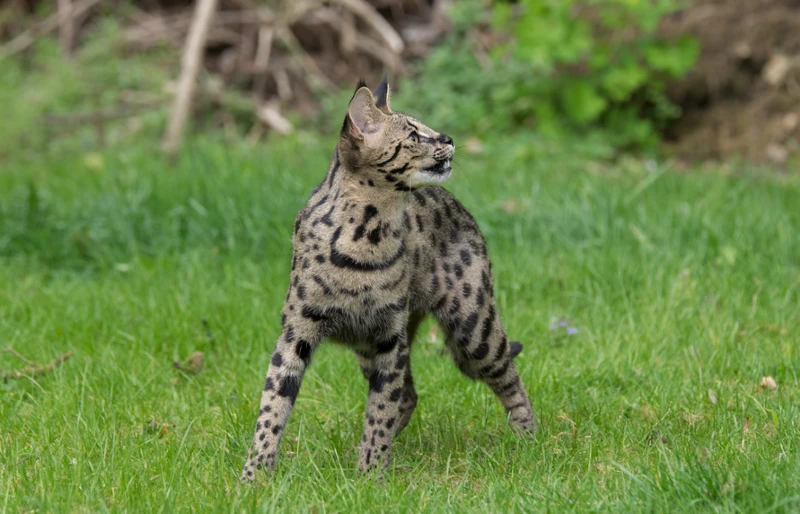
Click to Skip Ahead
If you thought cats don’t like water or can’t be trained to fetch or walk on a leash, you haven’t met the Savannah Cat. A tall, elegant feline with a dog-like personality, this hybrid breed displays feral and domestic traits, including wild solitary behavior and a friendly pet demeanor.
Savannah Cats are athletic and highly intelligent while remaining standoffish, especially with strangers, but extremely affectionate with their owners. Its strikingly spotted coat belays a lean cheetah-like physique crowned the world’s tallest domestic cat by the Guinness Book of Records.
This article contains more unique facts on the F1 generation of the Savannah Cat breed, including its history, identifying features, and how it gained popularity.
The Earliest Records of F1 Savannah Cats in History
In 1986, the F1 Savannah Cat was developed in the US by cross breeding a male African Serval with a female Siamese domestic cat. African Servals are wildcats spread over the sub-Saharan region, weighing between 20 to 40 pounds and mainly solitary.
The hybridization produces typically tall and lean offspring with the characteristic brown spotted coat and pointed ears of Servals.
Besides the Siamese gene pool, other breeds that contributed to what today is the F1 Savannah Cat, include spotted cats like the Oriental Shorthair, Bengal, and Egyptian Mau. Judee Frank, a cat breeder out of Pennsylvania, produced the initial hybrid on April 7, 1986, crossing a male Serval to breed a female, who was aptly named Savannah.
In 1989, a Turkish Angora male and an F1 Savannah later bred viable kittens, but almost 12 years would pass before the breed was registered with TICA, The International Cat Association. TICA also formally accepted the Savannah cat breed’s eligibility as a championship breed in 2021.

How the F1 Savannah Cat Gained Popularity
F1 Savannah Cats are named after their Serval parent’s habitat, and the feline’s grace and beauty echo the lush golden plains of that region. It’s a tall, lean, and relatively heavy cat with a long neck and legs, pointy ears, and a characteristic spot-patterned coat reflecting its wild African cousin.
Despite being a relatively new breed, the F1 Savannah Cat is popular, and there’s a wide network of breeders in North America and worldwide. The half-wild, half-domestic cats are prolific show felines, besides being sought-after house pets due to a high level of intelligence.
However, some say this cat has dog-like qualities, which become apparent as the feline follows its owner around or walks on a leash.
F1 Savannah Cats are high-energy pets, even when they’re several generations along the hybrid line, and their drive for play is intense. It’s a highly sociable cat loyal to its owner, but trainability is the most endearing trait that’s worked well for its popularity.

Formal Recognition of the F1 Savannah Cat
Various short-haired domestic cat breeds are crossed with African Servals to produce the F1 Savannah Cat, which results in many of its physical and behavioral characteristics. After the first Siamese cat pairing in 1986, many breeders contributed to the breed’s development. But notably, Joyce Sroufe, Patrick Kelley, and Lorre Smith contributed most to its formal recognition.
With Joyce and Karen Sausman’s help, Patrick wrote the first breed standards for the F1 Savannah cat in 1996, submitting it to the semiannual board meeting of TICA. But this meeting pronounced a two-year moratorium to revamp the association’s New Breed Program, a move extended for two more years in 1998.
The TICA moratorium ended in September 2000, and by the next month, Lorre Smith, a cat championship show participant and writer, submitted a new ‘Registration Only’ submission for the breed. That same year, the Savannah International Member & Breeder Association, or SIMBA, was formed, helping many breeders become TICA members.
Evaluation show status in 2001 allowed any F3 and lower generation Savannah Cats to enter shows and exhibits after Lorre presented the breeder’s accomplishments to TICA. As a result, SIMBA members exhibited at the Oklahoma City show for the first time in October 2002, and Lorre’s F3 Afrikhan Sophia won rave reviews from all judges.
Top 6 Unique Facts about The Savannah Cat
The F1 Savannah Cat is a unique feline breed that gets along with people, but depending on its generation, requires a significant commitment from pet owners.
Some unique facts about it include:
1. Savannah Cats of the F1 Generation Are Rare
F1 generation is the hybrid of a domestic shorthair bred with an exotic African Serval. These are rare because breeding is only sometimes successful, and they are not legal to keep as pets in several states.
2. Savannahs Are Expensive
Often, breeders need permits, and for F1 generation cats, Servals are rare and costly. You’ll come across purebred F1s costing more than $20,000, while an F2 may cost between $11,000 and $15,000.

3. Male F1 to F3 Savannahs Tend to Be Infertile
Due to crossbreeding, which makes them rare and costly, breeders often wait until the fourth generation to achieve a fertile male, which drives the cost of females closer to the Serval parentage as they’re more desirable.
4. F1 Savannah Cats Don’t Digest Corn-Based Foods Well
Their diet is mostly wet and dry combinations of raw or cooked meats. It’s often necessary to bottle feed kittens, especially if you’re rearing a crossbreed of the wild Serval. They also require fresh water even though they may play with it more than they’ll drink.
5. F1 Savannahs Are the Tallest Domestic Cats
According to the Guinness World Book of Records, the height goes to a feline named Magic, who stood 17.1 inches tall. Magic’s an F1 Savannah with a mother of a domesticated breed and a wild Serval sire.

6. Their Ownership Is Restricted
There are restrictions to owning an F1 Savannah Cat as a pet in the US, but these get lenient the further away from the Serval heritage the generation is bred. While laws vary in each state, Alabama and Hawaii don’t allow breed ownership due to the protection of wildlife species.
Does a Savannah Cat Make a Good Pet?
The F1 generation has 50% domestic and 50% Serval heritage, so it’s the least domesticated and isn’t a suitable pet for families with small kids and other pets. It is more challenging to care for as a pet than your typical domestic cat due to its heightened energy and athleticism levels.
As such, pet owners must dedicate significant time to provide care and exercise opportunities. Cat proofing homes with tight spaces like apartments is also necessary since the feline is a prolific jumper, and its inquisitive nature means fragile items aren’t safe.
F1 Savannah Cats can bond well with their owners, especially when you’ve raised it from a kitten, but that can’t be said for its attitude with strangers. The feline tends to show aloofness, and sometimes hostility to people or pets it’s not familiar with and won’t display a playful or docile temperament.
Therefore, the F1 Savannah Cat isn’t a popular pet to keep when you have very young children around. That’s especially true due to their size, strength, and wild behavior, which has led several states in the US to restrict its ownership.
Conclusion
The Savannah Cat is a unique hybrid breed with one paw in the wild and the other comfortable snuggling in your lap. It’s a handful that demands a lot of patience but provides adventurous and fun moments for families due to its intelligence and trainability.
Whatever the generation and Serval relation level in a Savannah Cat, they’re an intelligent, highly active, and curious breed. However, cat proofing is sometimes necessary, especially for F1s, as they can develop destructive behavior when they lack sufficient space for physical stimulation and exploration.
Featured Image Credit: Kolomenskaya Kseniya, Shutterstock







